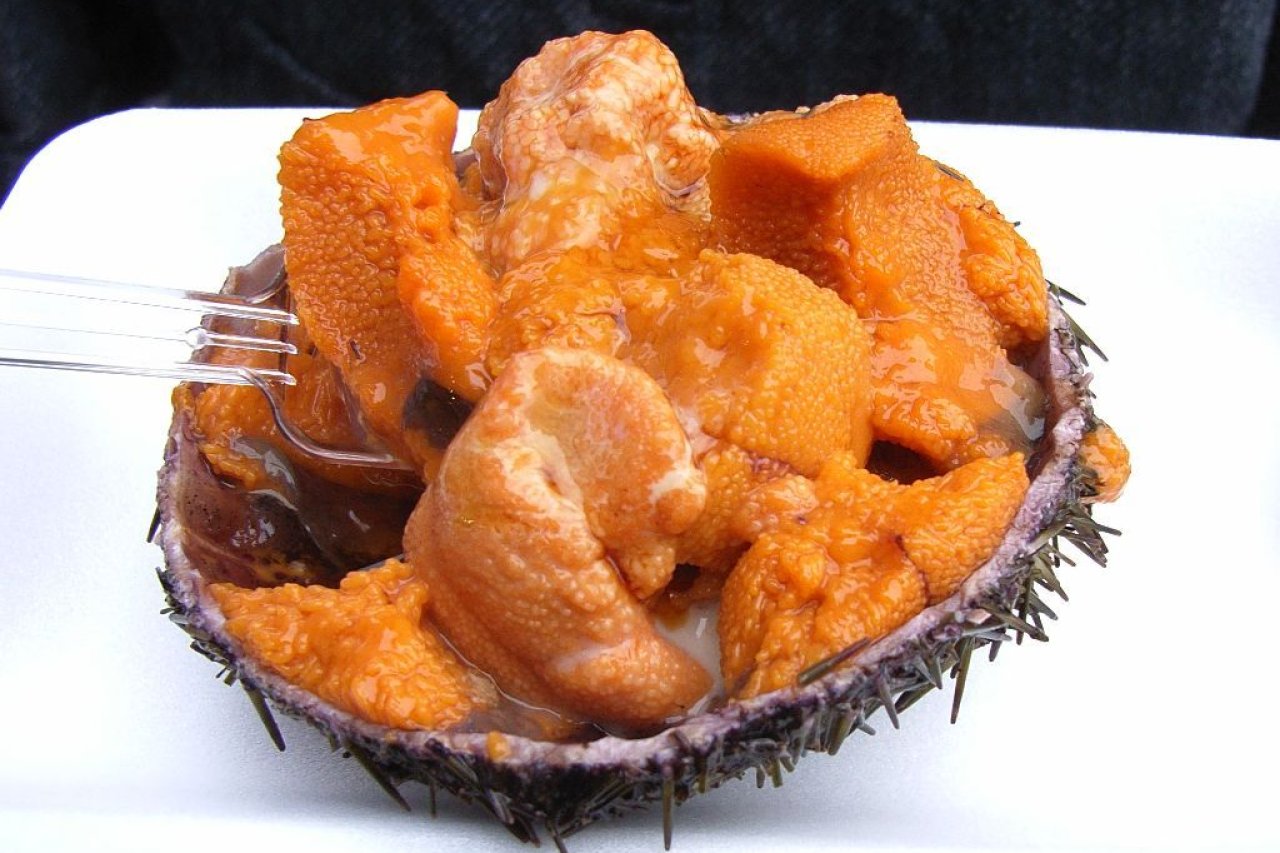Slurp. Slurp. This is messy work. No wonder diners at Wright Brothers in Spitalfields in London have their napkins tucked under their chins. Twisting the head off a carabinero, brown juices spurt over the sourdough toast. The juicy tail is perfectly complemented by a heady fino, parsley and garlic sauce. These scarlet prawns, named after the Spanish customs police's red uniforms, are relative newcomers to the British table. Fresh off the boat from Palamos on the Costa Brava, they are part of a new range of shellfish that are changing our eating habits. These carabineros taste sweeter and more luscious than lobster and almost the same size. No wonder they cost £28 a throw, chargrilled on a Himalayan salt block over charcoal, this summer's twist on the barbecue.
It's not just carabineros that are transforming the way we think about shellfish. Forget the ubiquitous prawn cocktail, so beloved of 1970s cuisine. There's the sea urchin, the percebes and the limpet. It's obvious that prawns, lobster and langoustines are a bit of a yawn. "Diners are becoming ever more adventurous and greedy for new experiences," says restaurateur Mitch Tonks.
At Wright Brothers, the most sought-after molluscs live in the luxury of huge purification tanks. They have become a star attraction. Such shellfish are usually "off-menu specials" as they're seasonal, wild and found only in remote locations. Difficult to harvest, they are often in short supply.
As Robin Hancock, co-owner of Wright Brothers explains, there's a great deal of theatre involved in eating crustacea. Whipping out a pair of shears, he decapitates a spiky sea urchin from the Faroe Islands where the season is longer than in the Mediterranean and quality is superlative. Revealing its five lobes, he offers up the tiny, silky fillets to eat raw straight from the shell with the urchin's spines still moving and scraping the plate.
Rarified molluscs require determined fisherman to bring them to the plate. High in the Arctic Circle, Roddie Sloan hunts sea urchins for a living. Fishing off the coast of Norway, he has played a key role in bringing sea urchins to a wider audience. He made his reputation supplying the chef René Redzepi at Noma in Copenhagen, one of the world's great restaurants. Now chefs who wish to emulate Redzepi are putting urchins on their menus, too. Sloan supplies top restaurants throughout Scandinavia, including Sweden's Faviken. Sloan, who styles himself as an underwater talent scout for shellfish, is now considering selling starfish.
At Fera restaurant in Claridge's hotel in London, the sea urchin features as a seasonal raw snack with sea herbs. "It's all about challenging diners and giving them a taste of that experience of a day at the beach with the wind in their faces," says head chef Dan Cox. Nuno Mendes, chef at the Chiltern Firehouse in London's Marylebone, plans to serve urchin in a ceviche using urchin eggs to enrich the tiger's milk marinade when he reopens his avant-garde restaurant, Viajante, next year.
So that he can serve urchins all year round, James Lowe of Lyle's in Shoreditch cures their tongues and uses them on a carpaccio of Highland beef. Sea urchin is not merely a London fad. At The Kitchin in Edinburgh, the chef-owner Tom Kitchin uses them in his signature Rockpool dish alongside winkles and limpets.
Shellfish are hardly the most handsome of creatures, but top prize for ugliness must go to those utter brutes, percebes. Found mostly in Spain and Portugal, they possess a scaly head that attaches itself to rocks and a diamond-shaped foot like a dinosaur claw. Many chefs simply steam them in salted water flavoured with bay leaves and charge up to £14 a go. A word of warning: don't tackle them with a knife and fork. The correct technique is to pinch the foot between thumb and finger and pull the glossy finger of inner tube flesh out of its scaly case, twist off the claw and slip down the flesh in one. Percebes boast a flavour similar to crab, with the texture of an oyster. There is an intense tang of the ocean.
It is Spain that has led the way in the appreciation of percebes, also known as gooseneck barnacles. Elena Arzak serves them at her Michelin-starred restaurant, Arzak, in San Sebastián. "They're jewels of the sea and provide a mouthful of the sea for our palate," she says. Costing more than €75 a kilo, percebes feature in all the top seafood restaurants in Madrid and Barcelona.
Arzak also serves sea anemones, offering them as a snack in a tempura-like batter. At Louis XV in Monaco, Alain Ducasse sources red San Remo prawns from the Italian Riviera. The brief season runs until September. Kenneth Culhane, chef at The Dysart in Richmond, plans to bring over some Irish abalone (sea snails) and see how his most adventurous diners react. "As with many ingredients enjoyed in Asian cuisine, it is about texture above all, which we are learning to appreciate more," he says.
Not all shellfish are as exotic as sea anemones. Cockles and whelks, traditional British seaside classics, are enjoying a revival. They are available all year and are relatively cheap. Whelks, for example, are £6 a kilo. Even Yoshinori Ishii, the chef at Umu in London's Mayfair, is championing sea snails, braised in soy, mirin, sake and ginger.
Shellfish aside, the other trend is that of "fin to tail" eating. Connoisseurs relish parts once discarded, such as cod's tongue and monkfish liver, known as the "foie gras of the sea". Michel Roux Jr of London's Le Gavroche has created a confit for a ragout with lentils and piment d'espelette spice.
Monkfish liver appears on the menu at the sushi restaurant Moshi Moshi in London where owner Caroline Bennett offers a snack of crispy prawn heads and encourages diners to eat the skeletons of their fish too. At Wright Brothers monkfish liver is sauteed with onions and finished with Pedro Ximenez sherry.
Quite the most extreme use of this fishy foie gras is to be found at Hibiscus in Mayfair. Here Claude Bosi makes it into ice-cream and serves it with fresh chestnut. The ultimate in piscatorial experimentation? Not for long.



















